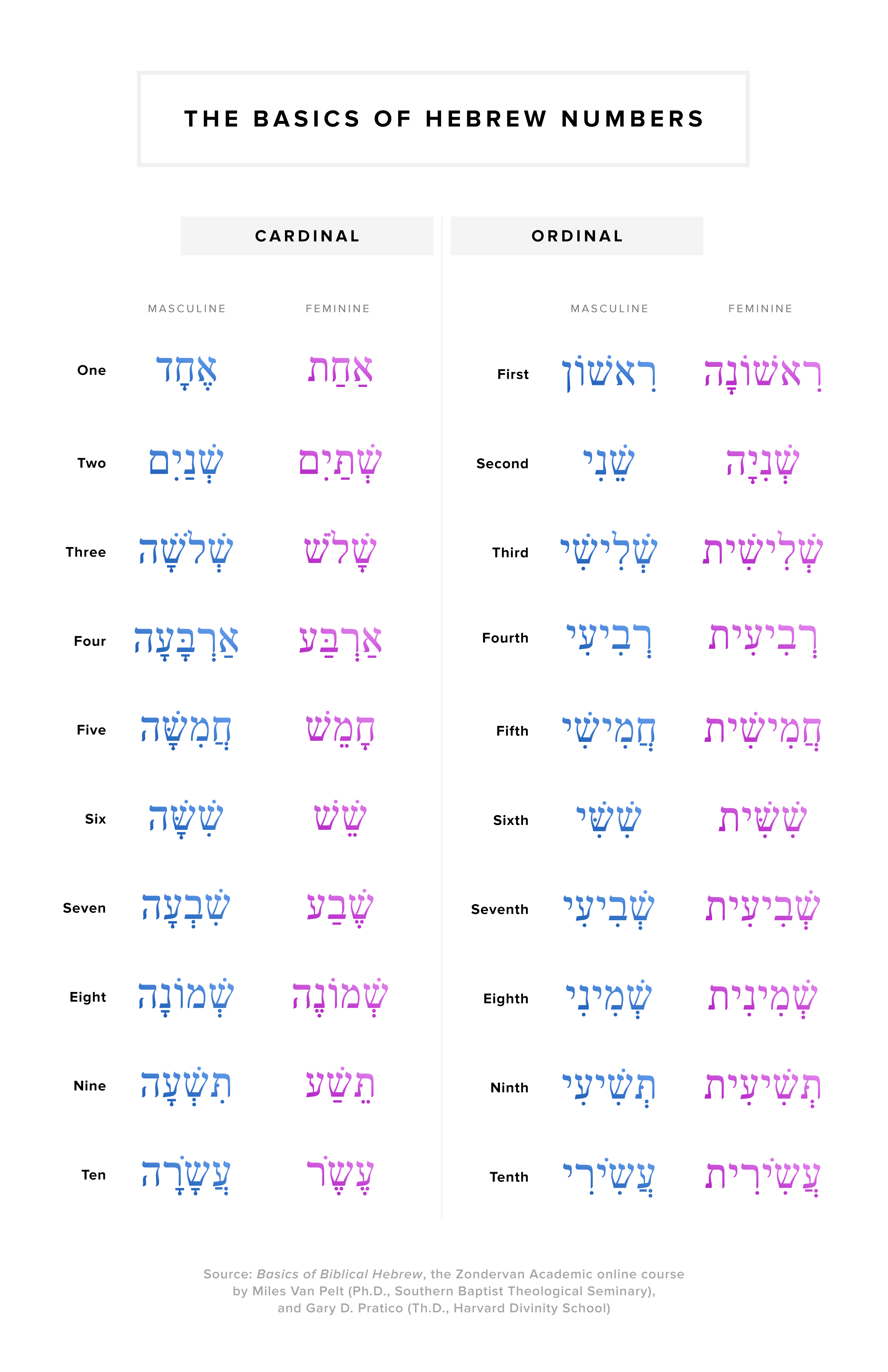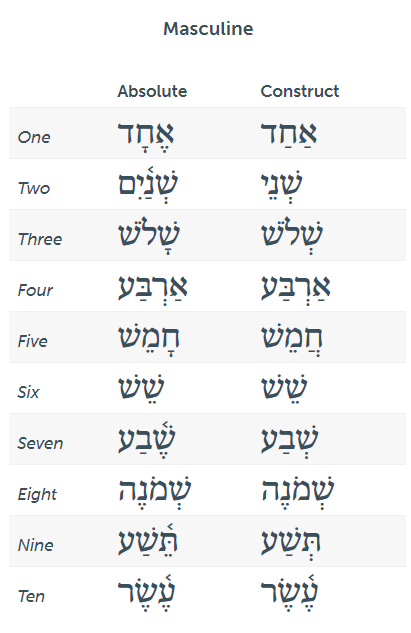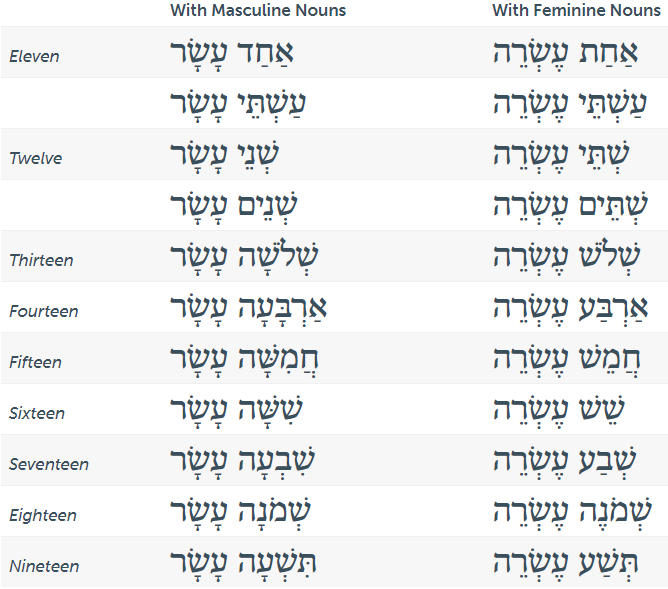The Basics of Hebrew Numbers

If you’re studying the biblical languages, you’ve probably noticed that numbers are handled very differently in ancient Hebrew than they are in English. While modern Hebrew uses European digits to represent numbers, biblical Hebrew has no numerical symbols, and is always written out.
These written numbers have masculine and feminine forms which have to agree with the gender of the noun they describe. (If there’s no noun, the feminine form is used.) To help you navigate the unique challenges of biblical Hebrew numbers, Dr. Miles Van Pelt and Dr. Gary Practico created an online course, Basics of Biblical Hebrew.
The video below explores their material, and you can hear Dr. Miles Van Pelt pronounce the numbers.

Learn to read the Bible in Hebrew.
Sign up for the Basics of Biblical Hebrew online course
Cardinal and ordinal numbers
In Hebrew, there are both cardinal and ordinal numbers.
Cardinal numbers are used for counting (one, two, three, etc.).
Ordinal numbers are used to indicate position in a series (first, second, third, etc.).
In addition to having masculine and feminine forms, cardinal numbers occur in both the absolute and construct states.
Hebrew numbers 1-10
You don’t have to memorize all of the following forms of the cardinal numbers. Instead, memorize only the masculine absolute forms and then note the types of changes that occur in the remaining forms. These changes indicate gender and state, which will be familiar to those who have studied basic Hebrew.
Give special attention to the spelling of numbers one and two.


With the number one, the masculine form is spelled with ד such as אֶחָד, and the feminine form with ת such asאַחַת.
The number one is used like an adjective.It follows the noun it modifies and agrees in gender and definiteness. When used in the construct state, “one” will precede an absolute noun that is usually plural.

With the number two, the masculine form is spelled with נ such as שְׁנַ֫יִם, and the feminine with ת such as שְׁתַּ֫יִם. Note that both forms are dual in number.
The number two is classified as a noun and agrees in gender with the other noun it relates to.The absolute and construct forms are used interchangeably without any apparent difference in meaning.

With numbers threethrough ten, there is no change in spelling, except to indicate gender and state. Like number two, these numbers are classified as nouns but they do not agree in gender with the other nouns they relate to.
Masculine forms of numbers 3-10 can be used with feminine nouns, and feminine forms of numbers 3-10 can be used with masculine nouns. Note also that while the numbers are singular in form, the nouns are plural.

Numbers two through ten may also occur with pronominal suffixes. These suffixes are added to the construct forms of the number.

Hebrew numbers 11-19
Numbers eleventhrough nineteenare formed with a combination of the number tenand onethrough nine. For example, the Hebrew number elevenis אַחַד עָשָׂר—a combination of one (אֶחָד) and ten (עֶ֫שֶׂר).

Note that eleven and twelve have alternate forms. The alternate forms for eleven (with עַשְׁתֵּי) occur only nineteen times in the Hebrew Bible.
Most of the time, numbers 11-19 occur with plural nouns. A few nouns, however, appear regularly in the singular. When singular nouns of this type occur with these numbers, they are translated as plural nouns. (See below.)

Ordinal numbers
As we said before, ordinal numbers are used to express position in a series (first, second, third, etc.). Like cardinal numbers, ordinal numbers have both masculine and feminine forms.
The ordinal רִאשׁוֹן (first) is derived from the noun רֹאשׁ(head, chief, beginning). The remaining ordinals share a common root with their corresponding cardinal number. For example, שֵׁשׁ (six) and שִׁשִּׁי (sixth) share a common root.
With ordinals second through tenth, the masculine form is distinguished from the feminine form by a final תin the feminine. In other words, masculine ordinals end with י ִas in שְׁלִישִׁי and feminine ordinals end with ית as in שְׁלִישִׁית.
Ordinal numbers are classified as adjectives. When attributive, they follow the noun they modify and usually agree in gender and definiteness.

For ordinals greater than tenth, cardinal numbers are used. (Such as numbers 11-19 above.)
Here are some examples of this from Scripture:

Key things to remember about biblical Hebrew numbers
As you explore the ancient Hebrew number system, keep these basics in mind:
- Cardinal numbers are used for counting (one, two, three, etc.) and ordinal numbers are used to indicate position in a series (first, second, third, etc.).
- In Hebrew, cardinal numbers have both masculine and feminine forms, and they occur in the absolute and construct states. In most instances, you need only to memorize the masculine absolute forms.
- While cardinal number one functions like an adjective, numbers two and higher function like nouns. Note that numbers three through ten do not agree in gender with the noun with which they are associated.
- Cardinal numbers eleven through nineteen are formed with a combination of the number ten and one through nine. For example, the Hebrew number eleven is אַחַד עָשָׂר, a combination of one (אַחַד) and ten (עָשָׂר).
- In Hebrew, the number twenty-one and other such numbers occur as either “twenty and one” or, less frequently, as “one and twenty.”
- Ordinal numbers are classified as adjectives and have both masculine and feminine forms. Masculine ordinals end in י as with שְׁלִישִׁי (third) and feminine ordinals end in ית ִas with שְׁלִישִׁית (third).
Learn to read the Bible in Hebrew.
Sign up for the Basics of Biblical Hebrew online course
This post is adapted from material found in the Basics of Biblical Hebrew online course.

Thank you!
Sign up complete.


